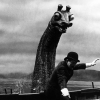BarnBuster
Virtually Unknown Member
On May 2, 2011, Osama bin Laden, the mastermind behind the September 11, 2001, terrorist attacks in the United States, is killed by U.S. forces during a raid on his compound hideout in Pakistan. The notorious, 54-year-old leader of Al Qaeda, the terrorist network of Islamic extremists, had been the target of a nearly decade-long international manhunt.
The raid began around 1 a.m. local time, when 23 U.S. Navy SEALs in two Black Hawk helicopters descended on the compound in Abbottabad, a tourist and military center north of Pakistan’s capital, Islamabad. One of the helicopters crash-landed into the compound but no one aboard was hurt. During the raid, which lasted approximately 40 minutes, five people, including bin Laden and one of his adult sons, were killed by U.S. gunfire. No Americans were injured in the assault. Afterward, bin Laden’s body was flown by helicopter to Afghanistan for official identification, then buried at an undisclosed location in the Arabian Sea less than 24 hours after his death, in accordance with Islamic practice.
Just after 11:30 p.m. EST on May 1 (Pakistan’s time zone is 9 hours ahead of Washington, D.C.), President Barack Obama, who monitored the raid in real time via footage shot by a drone flying high above Abbottabad, made a televised address from the White House, announcing bin Laden’s death. “Justice has been done,” the president said. After hearing the news, cheering crowds gathered outside the White House and in New York City’s Times Square and the Ground Zero site.
Based on computer files and other evidence the SEALs collected during the raid, it was later determined that bin Laden was making plans to assassinate President Obama and carry out a series of additional attacks against America, including one on the anniversary of September 11, the largest terrorist attack ever on U.S. soil, which left nearly 3,000 people dead. Shortly after the 2001 attack, President George W. Bush declared bin Laden, who was born into a wealthy family in Saudi Arabia in 1957 and used his multi-million-dollar inheritance to help establish al Qaeda and fund its activities, would be captured dead or alive. In December of that year, American-backed forces came close to capturing bin Laden in a cave complex in Afghanistan’s Tora Bora region; however, he escaped and would continue to elude U.S. authorities for years.
A break in the hunt for bin Laden came in August 2010, when C.I.A. analysts tracked the terrorist leader’s courier to the Abbottabad compound, located behind tall security walls in a residential neighborhood. (U.S. intelligence officials spent the ensuing months keeping the compound under surveillance; however, they were never certain bin Laden was hiding there until the raid took place.) The U.S. media had long reported bin Laden was believed to be hiding in the remote tribal areas along the Afghan-Pakistani border, so many Americans were surprised to learn the world’s most famous fugitive had likely spent the last five years of his life in a well-populated area less than a mile from an elite Pakistani military academy. After the raid, which the U.S. reportedly carried out without informing the Pakistani government in advance, some American officials suspected Pakistani authorities of helping to shelter bin Laden in Abbottabad, although there was no concrete evidence to confirm this.
Osama bin Laden’s Death Implications and Considerations
Operation Neptune Spear and Role of Technology
Getting Bin Laden
Last edited:






























